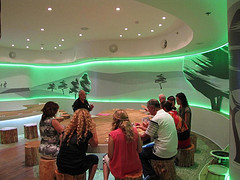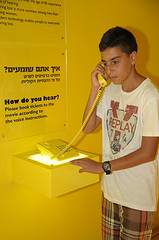Like its older siblings -- the highly popular "Dialogue in the Dark" and "Invitation to Silence" exhibitions that have allowed about 850,000 visitors to experience blindness and/or deafness -- “Dialogue with Time” is not really for kids. You have to be at least 14 to gain admittance. Its fun activities are all geared toward sparking a thoughtful dialogue about the social issues involved in aging.
"As a proud Israeli institution, we see it as part of our mandate to highlight perspectives of segments of human society that are all too often overlooked,” says Gil Omer, director general of the Children’s Museum. “We firmly believe that as a museum, our role is not simply to inform our guests but also to advocate for a better and more compassionate world."
Passport to the future
Before they enter the exhibition, visitors sit for a quick “passport photo” that will later be displayed on a large screen along with those of the other seven members of your group, doctored to show what you’ll look like in 30 years.
One room of the exhibition invites visitors to try putting a key in a door with shaking hands; text-message while wearing bulky gloves; sort colored pills quickly according to recorded instructions; view an eye chart through eyes afflicted with cataracts, glaucoma or macular degeneration; climb stairs wearing leaded booties; and accomplish assorted other tasks best done with a nimble mind and body.
Another exercise asks you to peruse a collection of photos to find the one that depicts how you want to look as an elder, and another illustrating how society views the elderly. This activity, too, is meant to spur dialogue.

Visitors choose photos that best depict how they want to look when they’re old
Our guide, Emanuel Dudai, is a robust 73-year-old retired journalist, military man and tour guide. Dudai was one of 50 people over 70 years old who passed the audition for the job, according to Omer. This policy follows the museum’s precedent of hiring blind guides for “Dialogue in the Dark” and deaf guides for “Invitation to Silence.”
Wise, not old
In a small theater, Dudai projected photos of his own life from childhood through grandparenthood, and reminded us that the Hebrew word for elder, zahken, means “wise man,” not “old man.” In Jewish tradition, elders are assumed to have acquired wisdom along with years.
Nevertheless, age discrimination is an issue in the modern, youth-oriented Israeli society.
“Older people are not obsolete, and being an old man is not a disease,” Dudai states during a post-exhibit wrap-up session in the “typical Israeli living room” where visitors sit surrounded by family photos of all the guides. “I was an army officer, and when I reached 50 they told me to go home.”
Dudai had previously guided the group through a trivia game on aging, complete with buzzers and computer graphics. Randomly during the action, he’d turn to certain players and order them to the sidelines with the phrase, “I don’t need you anymore.” At the end, he revealed that the real goal of the exercise wasn’t to test knowledge of trivia.
“I wanted you to see how it is to retire in the middle of life when you know so much and you’re so proficient. I was showing you that people retire not always because they’re fed up or don’t feel like working anymore but just because somebody said they had to,” says Dudai.

How is hearing affected by aging?
The new project was six years in the making by a design team headed by Golan Levy – the same designers for the two other experiential exhibits. It was funded by Israel's Ministry for Senior Citizens, MEITAV-The Organization for Welfare and Support Services, The Joint Distribution Committee-ESHEL, Keren L'Yedidut and Keren Nadav.
Every part of the exhibition is available in Hebrew and English, and bilingual guides are available when you call ahead to reserve. Because visitors go through in groups of eight, you must have a reservation.
Former Deputy Minister Lea Nes of the Ministry for Senior Citizens said the exhibit “provides a remarkable educational experience by allowing young people to literally step into the shoes of the elderly and experience what it feels like to age. In so doing, we are able to expand communal awareness and heighten the bond between the generations.”